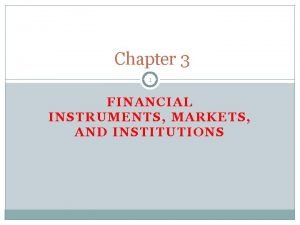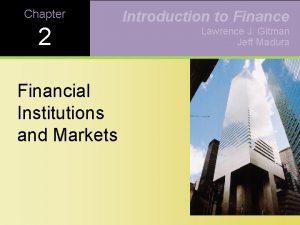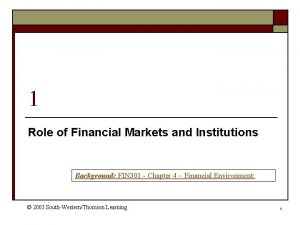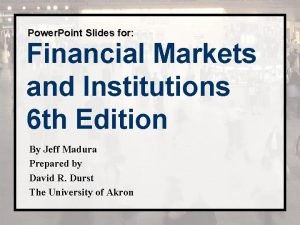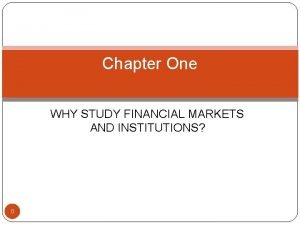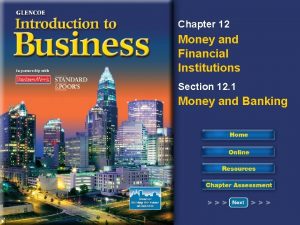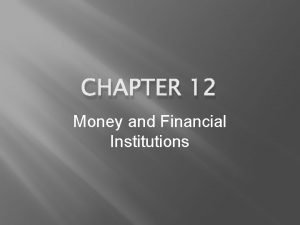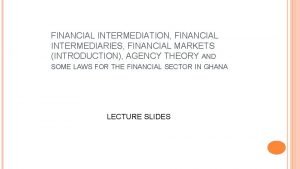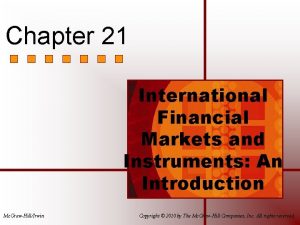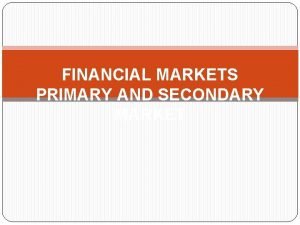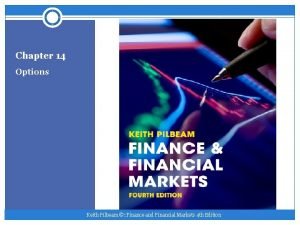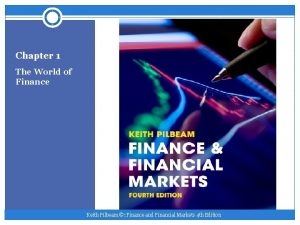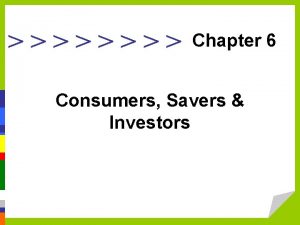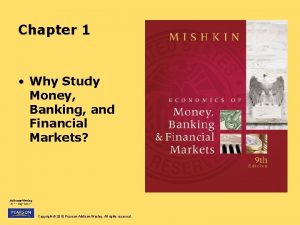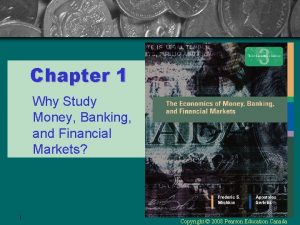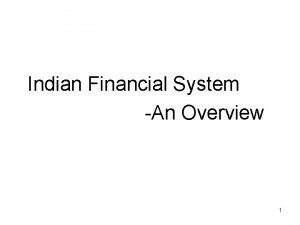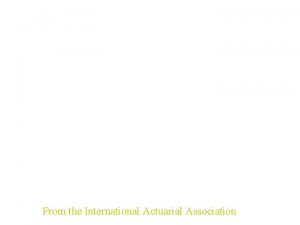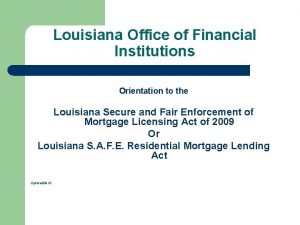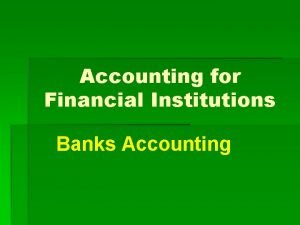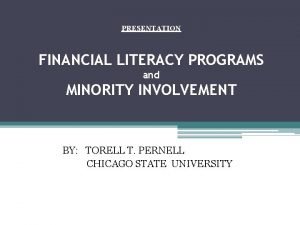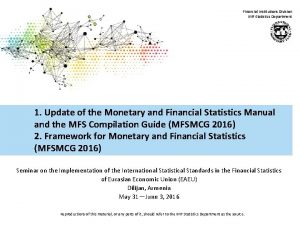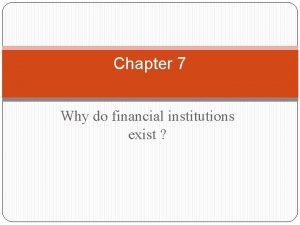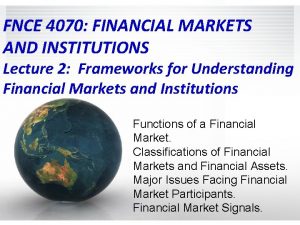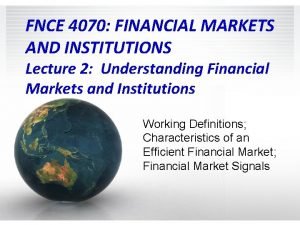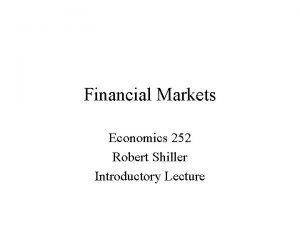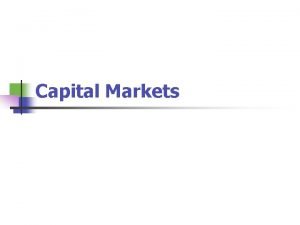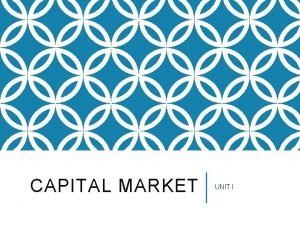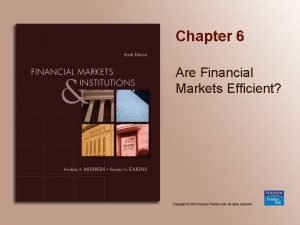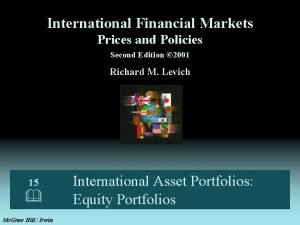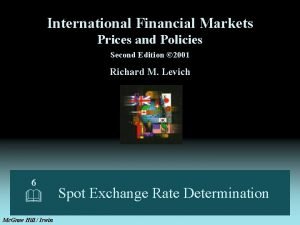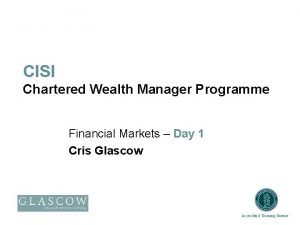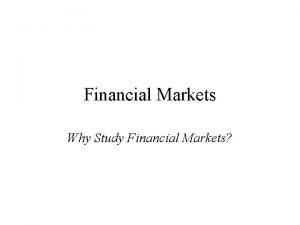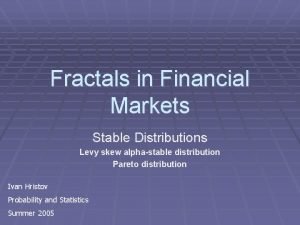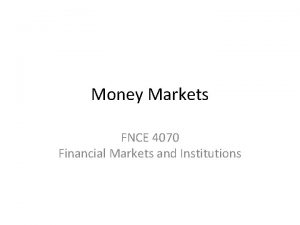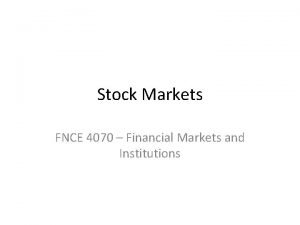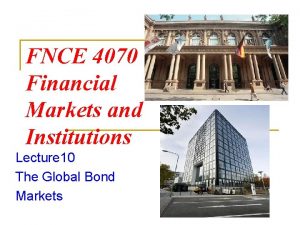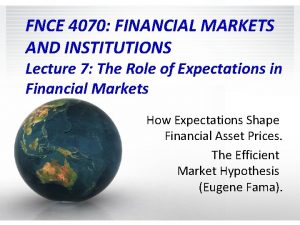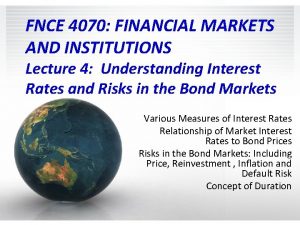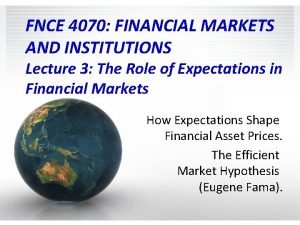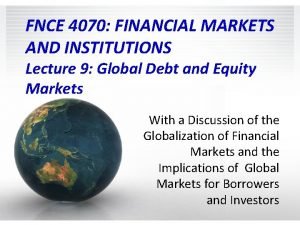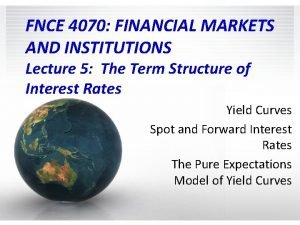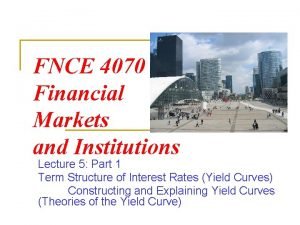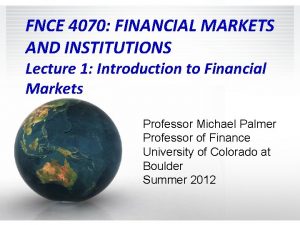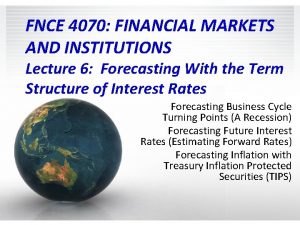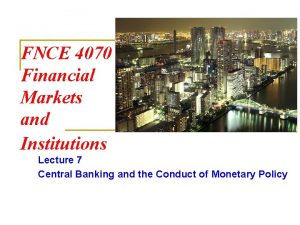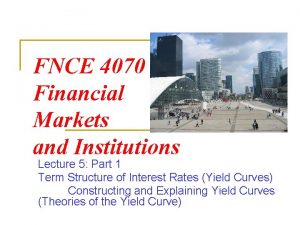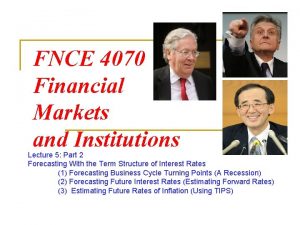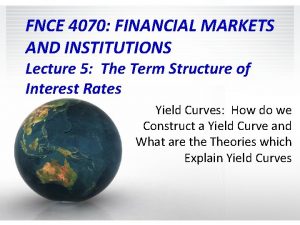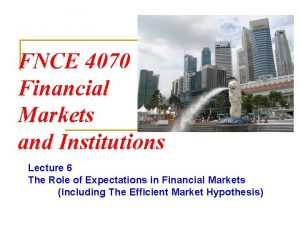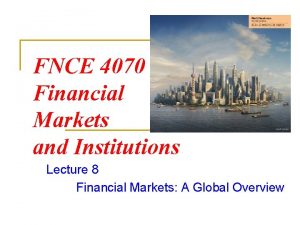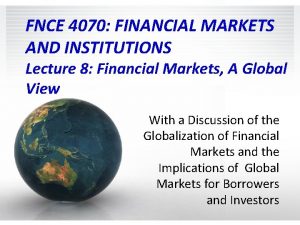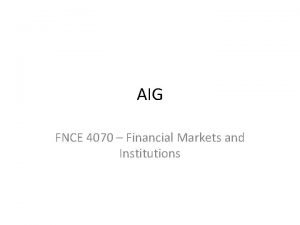FNCE 4070 Financial Markets and Institutions Lecture 5











































- Slides: 43

FNCE 4070 Financial Markets and Institutions Lecture 5: Part 2 Forecasting With the Term Structure of Interest Rates (1) Forecasting Business Cycle Turning Points (A Recession) (2) Forecasting Future Interest Rates (Estimating Forward Rates) (3) Estimating Future Rates of Inflation (Using TIPS)

Downward Sweeping or Inverted Yield Curve And Economic Activity Inverted Yield Curve Discussion n Inverted Yield Curve: An interest rate environment in which longterm debt instruments have a lower yield than short-term debt instruments of the same credit quality. This type of yield curve is the rarest of the three main curve types and is considered by some to be a predictor of an economic recession (i. e. , business cycle turning point). Why: An inverted yield curve signals a future fall in interest rates which is consistent with a recession.

Interest Rates and Business Cycles: 1969 – 1983

Interest Rate Spreads and Business Cycles: 1969 - 1983

Interest Rates and Business Cycles: 1987 – 2011

Interest Rate Spreads and Business Cycles: 1987 - 2011

Evidence from Australia

Evidence From the U. K.

Yield Curves and Recessions: The Evidence n Since the late 1980 s, many researchers have provided evidence that the yield curve, or specifically the spread between long term and short term interest rates, has been a predictive signal of future recessions. They include: q q q Arturo Estralla and Fredric Mishkin (June 1996), “The Yield Curve as a Predictor of U. S. Recession” (http: //www. newyorkfed. org/research/current_issues/ci 2 -7. pdf), found that the yield curve outperformed other financial and economic indicators in predicting recessions, especially 2 to 3 quarters into the future. Arturo Estrella and Mary R. Trubin July/August 2006 ”The Yield Curve as a Leading Indicator: Some Practical Issues” http: //www. newyorkfed. org/research/current_issues/ci 12 -5. pdf. Analyzed the yield spreads for six recessions from 1970 to 2001. Glenn D. Rudebusch and John C. Williams (July 2008), “Forecasting Recessions: The Puzzle of the Enduring Power of the Yield Curve”, found “that a simple model for predicting recessions that uses only realtime yield curve information would have produced better forecasts of recessions than professional forecasters”

Using Probit Analysis to Test the Probability of a Recession (Estrella and Trubin)

Using Probit Analysis to Test the Predictive Value of the Yield Curve (Estralla and Mishkin)

The Yield Curve and Interest Rate Forecasting n Two of the yield curve theories are especially relevant forecasting future interest rates. They are: q Pure Expectations Theory n q Liquidity Preference Theory n n Which assumes no liquidity premium for longer term debt instruments. Which incorporates a liquidity premium for longer term debt instruments. Both of these theories involves the role of forward rates in setting spot rates. q Thus we can arrange their formulas to calculate implied forward rates for any future period of time.

Forecasting with The Expectations n Recall that the Expectations Theory assumes that the Theory current long term spot interest rate is comprised of q q n Current (spot) short term interest rate (iss) and Expected, future (forward) short-term interest rates (ie). If we assume the long term spot rate (ils) is an average of short term rates (iss and ie), it is possible to derive the “expected” forward rate (ie), on a one-period bond for some future time period (n-t) through the following formula:

Forecasting With The Expectations Model: Example #1 n Assume the following: q q n Current 1 year spot (iss 1) = 5. 0% Current 2 year spot (ils 2) = 5. 5% Use the formula on the previous slide to calculate the implied forward rate, or the 1 year rate, 1 year from now:

Yield Curve For Example #1 Yield Curve The Forward Rate interest rate 6. 0% oie 5. 5 oils 2 5. 0 oiss 1 1 y 2 y Term to Maturity n n The calculated forward rate of 6. 00% is the market’s expected 1 year interest rate one year from now. This rate of 6. 00% becomes our forecasted interest rate using the pure expectations model.

Forecasting With The Expectations Model: Example #2 n Assume the following: q q n Current 1 year spot (iss 1) = 7. 0% Current 2 year spot (ils 2) = 5. 0% Use the formula on the previous slide to calculate the implied forward rate, or the 1 year rate, 1 year from now:

Yield Curve For Example #2 Yield Curve The Forward Rate interest rate 7. 0% oiss 1 5. 0 oils 2 3. 0 oie n 1 y 2 y Term to Maturity n The calculated forward rate of 3. 04% is the market’s expected 1 year interest rate one year from now. This rate of 3. 04% becomes our forecasted interest rate using the pure expectations model.

Using the Current Yield Curve Data to Forecast Interest Rates Bloomberg Data: U. S. Treasuries, Feb 24, 2011 COUPON MATURITY PRICE/YIELD 3 -Month 0. 000 05/26/2011 0. 11 / 0. 12 6 -Month 0. 000 08/25/2011 0. 15 / 0. 15 12 -Month 0. 000 02/09/2012 0. 23 / 0. 23 2 -Year 0. 625 02/28/2013 99 -28+ / 0. 73 3 -Year 1. 250 02/15/2014 100 -02+ / 1. 22 5 -Year 2. 125 02/29/2016 99 -11 / 2. 18 7 -Year 2. 625 01/31/2018 98 -20+ / 2. 84 10 -Year 3. 625 02/15/2021 101 -17+ / 3. 44 30 -Year 4. 750 02/15/2041 103 -17½ / 4. 53 Expectations Model What is the yield curve telling us about the markets expectation regarding future interest rates: Going up or going down? Can you approximate some forward rates? (1) 3 month rate, 3 months from now? (2) 1 year rate, 1 year from now?

Forecasting with the Liquidity Premium Theory n Recall that the liquidity premium theory modifies the expectations theory formula to take into account liquidity premiums (Ln), or q q n n Where, Ln is the liquidity premium for holding a bond of n maturity. Furthermore, Ln will always be positive. Given the addition of a liquidity premium an observed yield curve will always have an upward bias. So even if forward interest rates are expected to stay the same, the yield curve will slope upward.

Predictions of Future Interest Rate Moves with the LP Model Note: Solid yield curve is observed and broken line is taking out positive LP. (a): Implied increase in forward rate greater than LP. (b): Implied increase in forward rate equal to LP. (c): Implied decrease in forward rate slightly greater than LP. (d): Implied decrease in forward rate much greater than LP.

Forecasting Forward Rates with the Liquidity Premium Theory n The liquidity premium theory formula for calculating forward rates is as follows: n Therefore, in order to forecast an actual forward rate we need some estimate as to the liquidity premium (Ln), which insert into the above formula.

Estimating the Liquidity Premium (Ln) n U. S. Government Securities q q 1993 – 2007 data: Mean Returns n n n n 3 month: 3. 96% 6 month: 4. 13% 1 year: 4. 28% 2 year: 4. 60% 5 year: 5. 07% 10 year: 5. 42% 20 year: 5. 92% n Liquidity Spreads (in basis points) n n n n 3 months: ----6 months: +17 1 year: +32 2 year: +64 5 year: +111 10 year: +146 20 year: +196

Forecasting with the Liquidity Premium Theory: Example 1 n Assume the following: q q q n Current 1 year spot (iss 1) = 5. 0% Current 2 year spot (ils 2) = 5. 5% Liquidity premium (Ln) for 2 year debt = 32 basis points (64 -32). Use the liquidity premium formula to calculate the implied forward rate, or the 1 year rate, 1 year from now:

Forecasting with the Liquidity Premium Theory: Example 2 n Assume the following: q q q n Current 1 year spot (iss 1) = 7. 0% Current 2 year spot (ils 2) = 5. 0% Liquidity premium (Ln) for 2 year debt = 32 basis points (64 -32). Use the liquidity premium formula to calculate the implied forward rate, or the 1 year rate, 1 year from now:

Comparing Expectations and Liquidity Premium Forecasts Example 1 n n n 1 year rate: 5. 0% 2 year rate: 5. 5% Expectations Forecast = 6. 0% Liquidity Premium Forecast = 5. 36% Note: Expectations model overstated forecast for rising interest rates. Example 2 n n n 1 year rate: 7. 0% 2 year rate: 5. 0% Expectations Forecast = 3. 04% Liquidity Premium Forecast = 2. 41% Note: Expectations model understated forecast for falling interest rates.

An Actual Interest Rate Forecast Using interest rate data from March 9, 2011 Bloomberg site n as follows: n n 1 year T-Bills = 0. 24% 2 year T-Bills = 0. 69% n And assuming liquidity premium of 32 basis points for 2 year Treasury debt (see slide 22). n Using the liquidity premium forecasting model, calculate the 1 year rate, 1 year from now:

Market Segmentations Theory n Observation: Near the end of a business expansion (period before shaded areas) short term interest rates (blue line) exceed long term interest rates. q Thus, during this period we would observe a downward sloping yield curve.

Market Segmentations Theory: Explaining the Yield Curve Near the End of a Business Expansion n Why is there an inverted yield curve at this time? q q Interest rates have risen during the expansionary period and are now “relatively” high. Borrowers realizing that rates are relatively high, finance in the short term (not wanting to lock in long term liabilities at high interest rates). Lenders realizing that rates are relatively high, lend in the long term (wanting to lock in long term assets at high interest rates) Note: Both borrowers and lenders move away from their natural tendencies.

Market Segmentations Yield Curve Near the End of an Expansion i rate o Lenders supplying longer term funds (pushes down rates) o Borrowers demanding shorter term funds (pushes up rates) (st) Term to Maturity (lt)

Forecasting with the Market Segmentations Theory n n The Market Segmentations Theory CANNOT be used to forecast future spot rate (forward rates). The Market Segmentations Theory can be used to identify (signal) turning points in the movement of interest rates (and in the economy itself) based on the shape of the curve. q q Downward sweeping curve suggests a fall in interest rates, the end of an economic expansion, and a future economic (business) recession. Severe upward sweeping curve suggests a rise in interest rates, the end of an economic recession, and a future economic (business) expansion.

Summary of Yield Curves and Business Cycles

Estimating Future Rates of Inflation n Using the TIPS market to determine the “breakeven” inflation rate. q Assumption: n n n Conventional Treasury rate includes both real rate and inflation premium. TIPS rate is simply the real rate. Breakeven inflation rate = Yield to maturity on conventional Treasuries – Yield to maturity on TIPS. q q Important: Use similar maturities. Difference is the market’s annual inflation expectation over the maturity period.

U. S. Treasury Yield Curve Site for Observing Breakeven Rate of Inflation n Link to the U. S. Treasury site below for the nominal and TIPS yield curve. n n http: //www. treasury. gov/resource-center/data-chart-center/interestrates/Pages/Historic-Yield-Data-Visualization. aspx From this site, one can observe the breakeven inflation rate. q n Set the date for January 2, 2009 and observe the breakeven rate. q n n What is the most recent data telling you about the market’s expectation regarding inflation? What is this date telling you about the market’s expectation regarding inflation? From this site, one can also download the actual data. Note: The most recent 5 -year TIPS yield curve data point is incorrect (however, the actual data is correct). q According to the Treasury Department, the graphing function “is flawed. ”

Appendix 1 Why Do Markets Care about Yield Curves? The following is from Bonds on Line and summarizes why yield curves are important. http: //www. bondsonline. com/Corporate_Bond_Yield_Inde x. php#why

Using Yield Curves n n n “The shape of the yield curve is closely followed by bond investors. It provides information about the yields of short term compared to long term fixed-income investments. Investors analyze and interpret the yield curve shape to give some insights on the future direction of rates and the economy. A yield curve normally has an upward sloping shape. That is, in a normal yield curve, shorter-term yields are lower than longer-term yields, with yields generally increasing as years to maturity increase. The yields are higher on securities with longer maturities because these securities are more vulnerable to price changes caused by changes in interest rates over time. Investors in longer-term securities are typically rewarded with a higher yield for taking the risk that interest rates could rise and cause the prices of their securities to fall. Investors pay attention to both the current shape of the yield curve, whether it is steep or flat, and yield curve movements. That is, investors will look at whether the entire curve is shifting up or down in a parallel fashion which suggests that rates across the maturity spectrum are changing by the same magnitude or, alternatively, the shape or slope of the curve is becoming flatter or steeper. For example, when Federal Reserve monetary policy is more accommodative and reduces short term rates, the yield curve generally steepens, and flattens when monetary policy tightens the Fed raises short term rates.

Using Yield Curves n n When the yield curve is steep, that is when the difference between short -term and long-term yields is large, the market often expects interest rates to rise, though there a number of variables, including the rate of economic growth and inflationary expectations, that go interest rate analysis and forecasting; the risk at the long end of the maturity range is therefore greater, and so is the return or yield. When the yield curve is relatively flat, the difference between short-term yields and long -term yields is not that great. When this happens, the market is not rewarding investors for taking the risk of a longer maturity, possibly because the market believes interest rates will decline, causing bond prices to rise and yields to fall. Investors holding securities with longer maturities tend to benefit more from a declining interest rate trend. There have been brief and unusual periods of time when there has been what is known as an “inverted” yield curve shape, where, at certain points along the maturity spectrum, short-term yields have been higher than long-term yields. Inversely sloped yield curves are not sustainable – either short term yields will eventually fall or long term yields rise. An inverted yield curve is considered an omen of recession as well as lower interest rates. ”

Appendix 2 Ben Bernanke and the 2006 Yield Curve. Shortly after Bernanke became Chair of the Fed (Feb 1, 2006) he spoke before the Economic Club of New York. The presentation to that group was given on March 20, 2006. The yield curve which had been upward sweeping in 2004 (and thus normal) began to flatten in 2005 through 2006 and was approaching almost flat by the time Bernanke spoke. The following is a direct quote from Bernanke’s presentation regarding the flattening yield curve in 2006.

Ben Bernanke Discusses the 2006 Yield Curve n “Although macroeconomic forecasting is fraught with hazards, I would not interpret the currently very flat yield curve as indicating a significant economic slowdown to come, for several reasons. First, in previous episodes when an inverted yield curve was followed by recession, the level of interest rates was quite high, consistent with considerable financial restraint. This time, both short- and long-term interest rates--in nominal and real terms--are relatively low by historical standards. Second, as I have already discussed, to the extent that the flattening or inversion of the yield curve is the result of a smaller [liquidity] term premium, the implications for future economic activity are positive rather than negative. Finally, the yield curve is only one of the financial indicators that researchers have found useful in predicting swings in economic activity. Other indicators that have had empirical success in the past, including corporate risk spreads, would seem to be consistent with continuing solid economic growth. In that regard, the fact that actual and implied volatilities of most financial prices remain subdued suggests that market participants do not harbor significant reservations about the economic outlook. ”

Appendix 3 Central Bankers Bank of England ECB Bank of Japan Federal Reserve

Mervyn Allister King Governor, Bank of England n n n Mervyn King is Governor of the Bank of England is Chairman of the Monetary Policy Committee. He was previously Deputy Governor from 1998 to 2003, and Chief Economist and Executive Director from 1991. Mervyn King was a non-executive director of the Bank from 1990 to 1991. Born in 1948, Mervyn King studied at King’s College, Cambridge, and Harvard (as a Kennedy Scholar) and taught at Cambridge and Birmingham Universities before spells as Visiting Professor at both Harvard University and MIT. From October 1984 he was Professor of Economics at the London School of Economics where he founded the Financial Markets Group. Mervyn King is a Fellow of the British Academy, an Honorary Fellow of King’s and St John’s Colleges, Cambridge and holds honorary degrees from Birmingham, City of London, Edinburgh, London Guildhall, London School of Economics, Wolverhampton, Cambridge and Helsinki Universities. He is a Foreign Honorary Member of the American Academy of Arts and Sciences, is on the Advisory Council of the London Symphony Orchestra, is Patron of Worcestershire County Cricket Club and is a Trustee of the National Gallery.

Jean-Claude Trichet President, ECB n n n Jean-Claude Trichet was born December 20, 1942 in Lyon, France. A graduate of the University of Paris in Economics, Trichet also holds degrees in mining engineering and worked in the private sector before joining the French civil service. In the early 1970 s, Trichet was named the General Inspectorate of Finance, eventually becoming the Director of the Treasury Department in 1987. In 1993, Trichet accepted the position of Governor of the Banque de France and was reappointed to the same position in 1999. After serving as a member of the Council of the European Monetary Institute, Trichet was named to the Governing Council of the European Central Bank in 1998. On November 1, 2003, Jean. Claude Trichet was named President of the European Central Bank.

Masaaki Shirakawa Governor, Bank of Japan n n Governor Masaaki Shirakawa became the 30 th Governor of the Bank of Japan in April 2008. He joined the Bank in 1972, after graduating from the University of Tokyo with a B. A. degree in Economics. He also received an M. A. in Economics from the University of Chicago. Mr. Shirakawa assumed jobs with increasing responsibility throughout his career. He has held a number of senior positions. In 1990 -1993, he served as Director, Head of Financial System Division at the Financial and Payment System Office. In 19931994, he headed the Planning Division of the Policy Planning Office. In 1994 -1996 he served as General Manager for Oita Branch and General Manager for the Americas. In 1996 -1997, Mr. Shirakawa was Deputy Director-General of the Institute for Monetary and Economic Studies and of the International Department. Since 1997, he served as Adviser to the Governor at Credit and Market Management Department, Financial Markets Department and Policy Planning Office. He was appointed Executive Director in 2002. In addition to his policy work with the Bank of Japan, Mr. Shirakawa worked in academia, as Professor at the Kyoto University School of Government in 2006 -2008.

Ben S. Bernanke, Governor, Federal Reserve n n n Ben S. Bernanke began a second term as Chairman of the Board of Governors of the Federal Reserve System on February 1, 2010. Dr. Bernanke also serves as Chairman of the Federal Open Market Committee, the System's principal monetary policymaking body. He originally took office as Chairman on February 1, 2006, when he also began a 14 -year term as a member of the Board. His second term as Chairman ends January 31, 2014, and his term as a Board member ends January 31, 2020. Before his appointment as Chairman, Dr. Bernanke was Chairman of the President's Council of Economic Advisers, from June 2005 to January 2006. From 1994 to 1996, Dr. Bernanke was the Class of 1926 Professor of Economics and Public Affairs at Princeton University. He was the Howard Harrison and Gabrielle Snyder Beck Professor of Economics and Public Affairs and Chair of the Economics Department at the university from 1996 to 2002. Dr. Bernanke had been a Professor of Economics and Public Affairs at Princeton since 1985. Before arriving at Princeton, Dr. Bernanke was an Associate Professor of Economics (1983 -85) and an Assistant Professor of Economics (1979 -83) at the Graduate School of Business at Stanford University. His teaching career also included serving as a Visiting Professor of Economics at New York University (1993) and at the Massachusetts Institute of Technology (1989 -90). Dr. Bernanke has published many articles on a wide variety of economic issues, including monetary policy and macroeconomics, and he is the author of several scholarly books and two textbooks. He has held a Guggenheim Fellowship and a Sloan Fellowship, and he is a Fellow of the Econometric Society and of the American Academy of Arts and Sciences. Dr. Bernanke served as the Director of the Monetary Economics Program of the National Bureau of Economic Research (NBER) and as a member of the NBER's Business Cycle Dating Committee. In July 2001, he was appointed Editor of the American Economic Review. Dr. Bernanke's work with civic and professional groups includes having served two terms as a member of the Montgomery Township (N. J. ) Board of Education. Dr. Bernanke was born in December 1953 in Augusta, Georgia, and grew up in Dillon, South Carolina. He received a B. A. in economics in 1975 from Harvard University (summa cum laude) and a Ph. D. in economics in 1979 from the Massachusetts Institute of Technology.
 Financial markets and institutions - ppt
Financial markets and institutions - ppt Why study financial markets?
Why study financial markets? Participants of money market
Participants of money market Basic flow of funds through the financial system
Basic flow of funds through the financial system Madura j. financial markets and institutions
Madura j. financial markets and institutions Equity securities
Equity securities Madura j. financial markets and institutions
Madura j. financial markets and institutions Why study financial markets and institutions
Why study financial markets and institutions Chapter 12 money and financial institutions
Chapter 12 money and financial institutions Chapter 12 money and financial institutions
Chapter 12 money and financial institutions Financial intermediaries and markets
Financial intermediaries and markets International financial markets and instruments
International financial markets and instruments Capital markets and financial intermediation
Capital markets and financial intermediation Methods of floatation in primary market
Methods of floatation in primary market Financial markets and the allocation of capital
Financial markets and the allocation of capital Types of exchange rate
Types of exchange rate Pilbeam k. finance and financial markets
Pilbeam k. finance and financial markets Keith pilbeam
Keith pilbeam Chapter 6 consumers, savers, and investors answer key
Chapter 6 consumers, savers, and investors answer key Why study money banking and financial markets
Why study money banking and financial markets Why study money banking and financial markets
Why study money banking and financial markets Functions of financial institutions
Functions of financial institutions Introduction to financial institutions
Introduction to financial institutions Regulatory institutions in indian financial system
Regulatory institutions in indian financial system Types of non banking financial institutions
Types of non banking financial institutions Enterprise risk management for financial institutions
Enterprise risk management for financial institutions Louisiana office of financial institutions
Louisiana office of financial institutions Accounting for financial institutions
Accounting for financial institutions Financial literacy at minority serving institutions
Financial literacy at minority serving institutions Acrostic poem adalah
Acrostic poem adalah Imf
Imf Why do financial institutions exist
Why do financial institutions exist 01:640:244 lecture notes - lecture 15: plat, idah, farad
01:640:244 lecture notes - lecture 15: plat, idah, farad Classification of financial markets
Classification of financial markets Financial market classification
Financial market classification Financial markets shiller
Financial markets shiller Classification of financial markets
Classification of financial markets Classification of financial markets
Classification of financial markets Are financial markets efficient
Are financial markets efficient Levich international financial markets
Levich international financial markets International financial markets levich
International financial markets levich Cisi chartered wealth manager
Cisi chartered wealth manager Classification of financial markets
Classification of financial markets Fractals in financial markets
Fractals in financial markets



